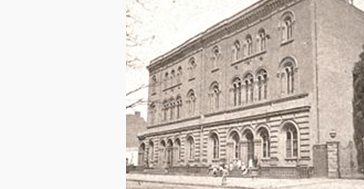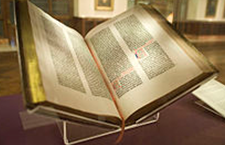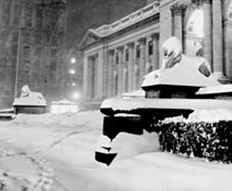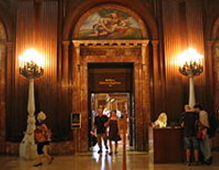

New York Public Library
Established 1895
Location New York, New York
Branches 87
Collection
Items collected Gutenberg Bible
Size 52,946,398[1]
Access and use
Population served 3,457,523 (Manhattan, The Bronx and Staten Island)
19,465,197 (State)
Other information
Budget $245,337,000[1]
Director Ann Thornton[2]
President and CEO, Anthony Marx[3]
Staff 3,147
Website www.nypl.org
The New York Public Library(NYPL) is a public librarysystem in New York City. With nearly 53 million items, the New York Public Library is the second largest public library in the United States (and third largest in the world), behind only theLibrary of Congress. It is an independently managed, nonprofit corporation operating with both private and public financing. The library has branches in the boroughs of Manhattan, TheBronxand Staten Island and it has affiliations with academic and professional libraries in the metropolitan area of New York State. The City of New York's other two boroughs, Brooklyn andQueens, are served by theBrooklyn Public Library and theQueens Borough Public Library, respectively. The branch libraries are open to the general public and consist of research libraries and circulating libraries.
The library originated in the 19th century, and its founding and roots are the amalgamation of grass-roots libraries, social libraries of bibliophiles and the wealthy, and from philanthropy of the wealthiest Americans of their age.
History

The New York Public Library main building during late stage construction in 1908, the lion statues not yet installed at the entrance
Founding

Astor Library
At the behest of Joseph Cogswell, John Jacob Astorplaced a codicil in his will to bequeath $400,000 for the creation of a public library.[4] After Astor's death in 1848, the resulting board of trustees executed the will's conditions and constructed theAstor Library in 1854 in the East Village.[5] The library created was a free, reference library, as its books were not permitted to circulate.[6] By 1872, the Astor Library was a "major reference and research resource",[7] but, "Popular it certainly is not, and, so greatly is it lacking in the essentials of a public library, that its stores might almost as well be under lock and key, for any access the masses of the people can get thereto".[8]
An act of the New York State Legislature incorporated the Lenox Library in 1870.[9] The library was built on Fifth Avenue, between 70th and 71st street, in 1877 and to it, bibliophile and philanthropist James Lenox donated a vast collection of his Americana, art works, manuscripts, and rare books,[10] including the first Gutenberg Bible in the New World.[7] At its inception, the library charged admission and did not permit physical access to any literary items.[11]

Lenox copy of the Gutenberg Bible in the New York Public Library
Former Governor of New York and presidential candidate Samuel J. Tilden felt that a library with city-wide reach was required, and upon his death in 1886, he bequeathed the bulk of his fortune—about$2.4 million—to "establish and maintain a free library and reading room in the city of New York".[7]This money would sit untouched in a trust for several years, until John Bigelow, a New York attorney, and trustee of the Tilden fortune, came up with an idea to merge two of the city's largest libraries.
Both the Astor and Lenox Libraries were struggling financially.[7] Although New York City already had numerous libraries in the 19th century, almost all of them were privately funded and many charged admission or usage fees.[citation needed] On May 23, 1895, Bigelow and representatives of the two libraries agreed to create "The New York Public Library, Astor, Lenox and Tilden Foundations". The plan was hailed as an example of private philanthropy for the public good.[7] The newly established library consolidated with the grass-roots New York Free Circulating Library, in February 1901.[12]
In March, Andrew Carnegie tentatively agreed to donate $5.2 million (presently, $1,434,992,000) to construct sixty-five branch libraries, with the requirement that they be maintained by the City of New York.[13] The Brooklyn and Queens public library systems, which predated the consolidation of New York City, eschewed the grants offered to them and did not join the NYPL system because they felt that they would not be treated equally with their Manhattan and Bronx counterparts.[citation needed] Later in 1901 Carnegie formally signed a contract with the City of New York to transfer his donation to the city to then allow it to justify purchasing the land to house the libraries.[14] The NYPL Board of trustees hired consultants, and then accepted their recommendation that a very limited amount of architectural firms be hired to build the Carnegie libraries so as to assure uniformity of appearance and to minimize cost. Consequently, the trustees hired McKim, Mead & White, Carrère and Hastings, and Walter Cook to design all the branch libraries.[15]

Cross-view of classical details in the entrance portico
Collection development
The famous New York author Washington Irving was a close friend of Astor for decades and helped the philanthropist design the Astor Library. Irving served as President of the library's Board of Trustees from 1848 until his death in 1859, shaping the libraries collecting policies with his strong sensibility regarding European intellectual life.[16]Subsequently the Library hired nationally prominent experts to guide its collections policies; they reported directly to directors John Shaw Billings(who also developed the National Library of Medicine), Edwin H. Anderson, Harry Miller Lydenberg, Franklin F. Hopper, Ralph A. Beals, and Edward Freehafer (1954–70).[17] The emphasized expertise, objectivity and a very broad world-wide range of knowledge in acquiring, preserving, organizing, and making available to the general population nearly 12 million books and 26.5 million additional items.[18]The directors in turn reported to an elite board of trustees, chiefly elderly, well-educated, philanthropic, predominantly Protestant, upper-class white men with commanding positions in American society. They saw their role as protecting the library's autonomy from politicians as well as bestowing upon it status, resources, and prudent care.[19]
Representative of many major decisions was the purchase in 1931 of the private library of Grand Duke Vladimir Alexandrovich (1847–1909), uncle of the last tsar. This was one of the largest acquisition of Russian books and photographic materials, and was made possible by the Soviet government's policy of selling its cultural collections abroad for gold.[20]
The military made heavy use of the Library's map and book collections in the world wars. For example, the Map Division's chief Walter Ristow became head of the geography section of the War Department's New York Office of Military Intelligence from 1942 to 1945. Ristow and his staff discovered copied and loaned thousands of strategic, rare or unique maps to war agencies in need of information not available through other sources.[21]
Main branch building
The organizers of the New York Public Library, wanting an imposing main branch, chose a central site available at the two-block section of Fifth Avenue between 40th and 42nd streets, then occupied by the no-longer-needed Croton Reservoir. Dr. John Shaw Billings, the first director of the library, created an initial design which became the basis of the new building (now known as the Schwarzman Building) on Fifth Avenue. Billings's plan called for a huge reading room on top of seven floors of bookstacks combined with a system that was designed to get books into the hands of library users as fast as possible.[7]
Following a competition among the city's most prominent architects, Carrère and Hastings was selected to design and construct the building.[22] The cornerstone was laid in May 1902,[23] and the building's completion was expected to be in three years.
In 1910, 75 miles (121 km) of shelves were installed, and it took a year to move and install the books that were in the Astor and Lenox libraries.[7]
On May 23, 1911, the main branch of the New York Public Library was officially opened in a ceremony presided over by President William Howard Taft. After a dedication ceremony, the library was open to the general public that day.[24] The library had cost $9 million to build and its collection consisted of more than 1,000,000 volumes.[25] The library structure was a Beaux-Arts design and was the largest marble structure up to that time in the United States.[26] It included two stone lions guarding the entrance were sculpted by E. C. Potter.[27] Its main reading room was contemporaneously the largest of its kind in the world at 77 feet (23.5 m) wide by 295 feet (89.9 m) long, with 50 feet (15.2 m) high ceilings.[23]It is lined with thousands of reference books on open shelves along the floor level and along the balcony. The New York Public Library instantly became one of the nation's largest libraries and a vital part of the intellectual life of America.[citation needed] Dr. Harry Miller Lydenberg served as director between 1934–1941.[28]

"Patience" and "Fortitude", the "Library Lion" statues, in the snowstorm of Dec. 1948

Entrance to the Public Catalog Room

The Map Division



















